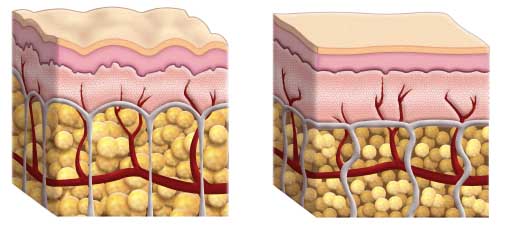What is it?
Cellulite is dimpled skin that may appear like an orange peel commonly on the thighs and buttocks. Â Most women after puberty will develop cellulite. Â It affects the vast majority of women, usually after puberty. Cellulite is not strictly a problem with excess fat. Â Even thin women can have cellulite. Â Rapid weight loss can actually make cellulite worse.
How did it get there?
Cellulite is not your fault. Â There are no known ways to prevent cellulite. Men, however, rarely develop it.
There are three anatomic problems that cause the “cottage cheese†appearance of cellulite. First, the connective tissue bands around the fat under the skin become stiff and taut.  Second, enlarged pockets of fat trapped by the rigid bands herniated into the skin. Finally, thin skin allows all of these changes to been seen more easily.  See the diagram below with skin affected by cellulite on the left and normal skin on the right.

Aging, hormones, genetics and dramatic weight changes can all play a role in the appearance of cellulite.
Cellulite can be divided into three main grades based on the severity. Grade I cellulite is only seen when the skin is pinched. Â Grade II cellulite can be seen when standing up but not when lying down. Â Grade III cellulite can be seen whether you are standing up or lying down.
Can cellulite be treated?
There are many treatments offered for cellulite. Â None are perfect and there is no way to prevent getting cellulite. Â Treatment methods must address at least one of the anatomic causes of cellulite described above.
1. Reduce the Fat:
Weight loss lessens the appearance of cellulite in most women. Â However, even thin women can have cellulite
Liposuction can reduce the volume of deep subcutaneous fat but does not easily address the superficial fat that herniates into the dermis. Â Removing this fat by liposuction can cause further skin dimpling and scarring. Laser assisted liposuction has the same limitations as traditional liposuction but may lessen the appearance of cellulite by tightening the skin.
2. Tighten the Skin:
Topical Treatments may improve the firmness and appearance of skin, lessening the appearance of cellulite. Â Topical treatments do not address the issues below the skin that lead to cellulite.
Endermologie uses rolling pressure and suction to reduce the appearance of cellulite. Â It requires up to 20 twice weekly treatments. Â In published studies, the results are mixed and often temporary. Â Monthly maintenance may be recommended.
3. Break up the Fibrous Bands:
Cellulazeâ„¢ is an invasive procedure approved by the FDA for cellulite reduction that uses a Nd:YAG laser to melt the fat and break up the fibrous bands that lead to cellulite.
4. All of the Above
SmoothShapesâ„¢ uses a diode laser, massage, and suction to reduce cellulite and address small areas of unwanted fat for body contouring.
VelaShapeâ„¢ is a noninvasive treatment that uses a combination of radiofrequency, infrared light, massage, and suction to heat collagen and fat in the skin which leads skin tightening, degradation of fibrous bands, and fat reduction in treated areas.
